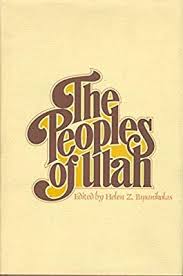Articles/Essays – Volume 11, No. 3
Ethnic Utah | Helen Z. Papanikolas, ed., The Peoples of Utah
The Peoples of Utah, edited by that able scholar, Helen Z. Papanikolas, and published under a grant from the Utah American Revolution Bicentennial Commisson, provides a welcome reassessment of Utah’s many nationalities. It comprises fourteen chapters, covering almost the full range of ethnic representation, except for the Northern Indians and the Basque peoples. Chapters are written by such recognized experts as Floyd A. O’Neil, Frederick Buchanan, William Mulder, Davis Bitton, Maureen Ursenbach Beecher, and Helen Papanikolas. Though not as extensive as works like The Gentile Comes to Utah (Robert Dwyer) and the Indians of Utah (Jesse Jennings, Elmer Smith, Charles Dibble), they have enough depth to give the reader a basic understanding of each group.
The introduction (written by the editor) presents the premise that Utah started as an agrarian society of Mormons seeking isolation from the larger world among the Indian settlements. But by the turn of the century the inevitable influx of settlers from afar had turned Utah into a cosmopolitan state. It was not until after World War II, however, that the culture stabilized enough for groups to feel somewhat free of racial and religious prejudice. By this time most of the Indians, British, Scandinavians, Jews, Asians, Middle Easterners, Greeks and Blacks had been accepted into the society and their leaders recognized for various achievements.
Each article plays off the background of the Mormon settlement, but each goes beyond this setting to show the peculiarities of each group. As Buchanan and Mulder conclude, the Mormon Church was an Americanizing institution, especially for the British and the Scandinavians, but they and other nationalities stubbornly preserved many of the traditions of their homelands.
To the credit of the editor, each article builds from and relates to the others, presenting an excellent summary of Utah’s ethnic development. The authors are sympathetic to the cultures they examine, and they avoid dealing with such problems as crime, violence, prostitution, opium traffic and other problems that have plagued these groups in Utah as elsewhere, problems which sometimes express the frustrations of an oppressed people in an unsympathetic society. Only the Davis Bitton-Gordon Irving article on the Continental Europeans deals with crime, and then only briefly. A few references emerge elsewhere in the volume, when opium dens and strikes in the coal mines figure prominently in the narrative.
Nevertheless, the book rings true, and it will create a better appreciation of the variety of peoples and their heritage that have enriched Utah’s history.
The Peoples of Utah. Edited by Helen Z. Papanikolas. Salt Lake City: Utah State Historical Society, 1976. 499 pp. $7.50.


 Back to full Issue
Back to full Issue

